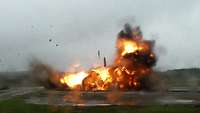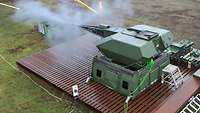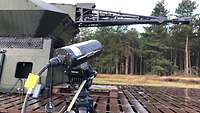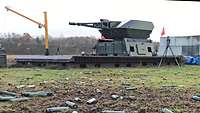
WTDWehrtechnische Dienststelle 91: Detonation of a Bunker Buster
A new aircraft bomb is tested at the premises of WTDWehrtechnische Dienststelle 91.


Heiko Meißner takes a satisfied look through the thick clouds of smoke at the target riddled with holes. The cause — an olive-green gun turret — is barely visible through the smoke. “So far the barrels have lasted longer than we had anticipated,” states the 50-year-old from Emsland. Meißner is a test manager at the Bundeswehr Technical Center for Weapons and Ammunition in Meppen (WTDWehrtechnische Dienststelle 91) and has been firing the Mantis air defense system incessantly into a mound for several days now.
The Bundeswehr procures new barrels for the Mantis air defense system. At the Bundeswehr Technical Center for Weapons and Ammunition (WTDWehrtechnische Dienststelle 91) the barrels are fired until they break.

Mantis neutralizes rockets, artillery and mortar rounds (so-called RAMRolling Airframe Missile targets) but also aerial targets like drones or cruise missiles
Bundeswehr/WullersThe acronym Mantis stands for “Modular, Automatic and Network-capable Targeting and Interception System”. It consists of several sensor units, an operations and fire control center as well as several gun turrets. “Mantis was procured in 2011 to protect German camps abroad and is able to engage aerial threats with up to six 35 mm automatic cannons,” explains Heiko Meißner. Every single one of these guns is capable of firing up to 1,000 rounds per minute.
Nevertheless, before the new barrels can be delivered to the Air Force, WTDWehrtechnische Dienststelle 91 must test the quality of the new production series. “We shoot until the barrels break and carry out measurements beforehand, during and afterwards in order to test the properties and performance data of the new barrels,” is how Heiko Meißner explains the process.

The Bundeswehr Technical Center for Weapons and Ammunition tests the barrels’ performance with state-of-the-art sensors. Only if the barrels are able to withstand gunfire can the soldiers‘ safety be guaranteed.
Bundeswehr/WullersNumerous areas of WTDWehrtechnische Dienststelle 91 are involved in this process. “Our workshops have welded and assembled parts. The measuring engineers are present and have X-rayed the barrels. The ammunition arsenal and the weapons engineers were on site, among many others,” says Meißner listing his helpers. “Not to forget the manufacturer, who has been actively supporting us in the implementation process for weeks.”
Heiko Meißner himself can also rely on his many years of experience as a soldier. “I was stationed at the Lorup ammunition storage site until 2009,” states Meißner, who was born in Lingen. “Since then, I’ve been with WTDWehrtechnische Dienststelle 91 in Meppen.” In addition to Mantis, he is also responsible for tests relating to the new PUMA armored infantry fighting vehicle. “I certainly don’t get bored here,” says the technical civil servant with a smile.

Mantis fires 35 mm rounds. The spent cartridge cases are ejected on the side of the gun.
Bundeswehr/WullersAround 4,000 rounds and three barrels are used up at the end of the Mantis tests. WTDWehrtechnische Dienststelle 91 in Meppen will now report the results to BAAINBwBundesamt für Ausrüstung, Informationstechnik und Nutzung der Bundeswehr in Koblenz, which is responsible for procurement. The perforated targets will now get a short break. “Our gun here has fired a total of over 22,000 rounds and has earned a break,” says Heiko Meißner and takes another satisfied look through the clouds of smoke at the target riddled with bullets.
by Dr. Dominik Wullers